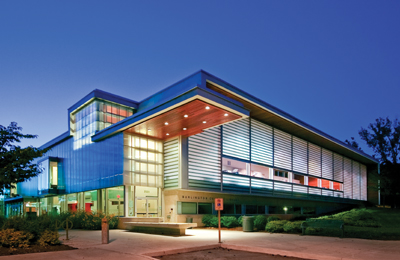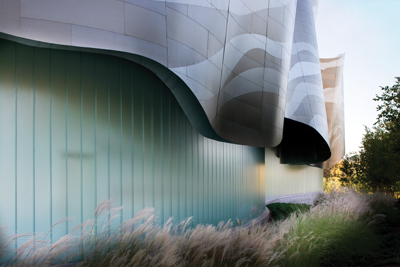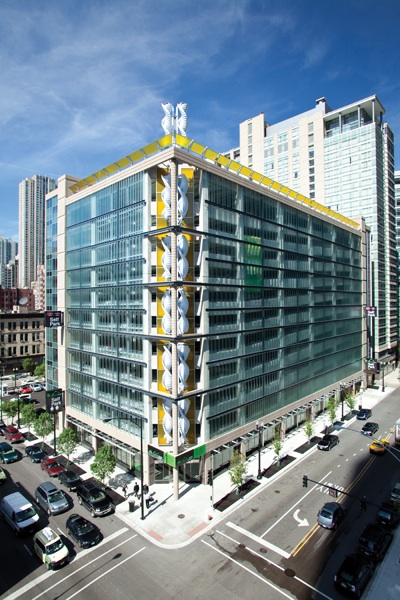
Technology
Hardware & glazing systems
INNOVATIONS: October 2011
Daylight and design: Light becomes a design tool with channel glass technologies.
October 31, 2011 By Jeff Razwick
Channel glass first made headlines
for its ability to diffuse large amounts of daylight deep into interior
spaces without glare or excessive shadows, while reducing heat transfer.
Today, although channel glass remains an effective daylighting
material, many building professionals recognize that its unique depth,
profile and light-transmitting qualities can also contribute to the art
of building design.
Channel glass first made headlines for its ability to diffuse large amounts of daylight deep into interior spaces without glare or excessive shadows, while reducing heat transfer. Today, although channel glass remains an effective daylighting material, many building professionals recognize that its unique depth, profile and light-transmitting qualities can also contribute to the art of building design. Whether by shape, texture or colour, it can make modern glazed applications worth looking at, not just through.
 |
|
| Large, glazed spans of channel glass add drama to a library. New channel glass products can span up to seven metres, making them ideal for exterior applications. (Photo courtesy of TGP) Advertisement
|
Design basics
Channel glass systems consist of U-shaped, translucent cast-glass channels mounted in an aluminum perimeter frame. While these linear glazed segments can capture and transfer large amounts of daylight, they can also form an esthetic not possible with conventional windows or glass block. For instance, cast-glass channels in vertical and horizontal installations can span up to seven meters without interruption. They can also form curved or serpentine configurations.
The channels are dual-glazed for exterior applications and can be single- or dual-glazed for interiors. Due to their ability to capture natural light, common exterior applications include storefronts and facades, wall systems, windows and strip lighting. As discussed in the following sections, varying channel glass colour, texture and orientation allows such systems to contribute to building envelope performance without detracting from contemporary design. Common interior applications include partition walls (as the channels help maintain privacy while still admitting light), as well as object architecture.
Channel glass is available in a variety of colours and textures with varying translucency, allowing for the transfer of diffuse light in a sophisticated manner.
Designing by shape
One popular trend is to install long, linear sequences of channel glass. Because interim framing is not required in vertical applications and the systems can be stacked over floor slabs to achieve greater heights, designers can use channel glass systems for large, dramatic glazed areas. When installed vertically, these glazed expanses can create the sleek, understated esthetic desirable in many contemporary buildings. Horizontal applications often appear more geometrical in form.
Another option is to intermix or vary channel glass orientation and length, adding dimension and depth to building designs. For instance, arranging the linear glass strips in a vertical pattern separated by windows or framing units is a simple yet efficient way to create eye-catching facades. Conversely, when a subtler look is desired, architects can place vertical cast-glass panels with openings between them (as they do not require intermediate mullions). This can bring an ethereal element to buildings and, on a practical level, allow for air ventilation if protection from the outside elements is not required.
A growing design trend is to install curved or serpentine configurations. The slender frames and narrow glazed segments in channel glass systems allow for tighter radii than conventional glass: as low as 1.9 metres. Such compact arcs can ebb and flow like water, encircle stairwells or represent landscapes and emotive themes, accentuating sophisticated designs
Thanks to manufacturing advancements, design professionals can use the sleek shape of channel glass to their advantage, regardless of building location (see sidebar).
Designing by texture
Varying the texture of glass influences two key design elements: interior lighting and movement. For instance, channel glass with no surface patterning is monolithic in appearance and provides only a moderate level of translucency. By comparison, channel glass with a thin, net-like texture disperses softer light for greater privacy.
Channel glass textures range from no surface patterning to wave-like textures that create dramatic optical variations by prismatically bending light and varying its distribution. Incorporating channels with larger wave-like texture patterns typically results in more sophisticated light play, whereas keeping the same texturing throughout creates a more homogeneous look.
Designing by colour
Design professionals can use channel glass to make artistic statements with surface colour. The standard translucent channel glass hue is a light seafoam green. Additional translucent colours include amethyst, bronze and clear. Providing only a hint of surface colour, these channels allow for strong passage of natural light while subtly complementing a building’s colour scheme.
 |
|
| Serpentine channel glass can visually link a retail store with its surrounding landscape. (Photo courtesy of TGP)
|
For object architecture or catchy storefronts, architects can select from a range of standard polycarbonate laminate options and over 1,500-tempered ceramic frit colours within the RAL design system. With the colour melded to the interior surface of the glazing during manufacturing, coloured ceramic frits are opaque and can create bold accents. Two other design-savvy options are to include colour-coating metallics and to apply lettering or other shapes with decals or custom painting.
Where a more light-obscuring appearance is desirable, design professionals may wish to consider sandblasted channels. Such treatment achieves greater opacity and is ideal for spaces like offices, entryways and lounges that require both light and privacy.
Regardless of the colour chosen for the channel glass system, lights can be set between it and a wall to create backlit screens that display one or more colours. In many instances, interior applications such as partitions and focal points are lit by day and night. Exterior applications, on the other hand, are often backlit only at night. This allows them to take full advantage of the sun’s natural light by day, yet function as a visual landmark for customers by night.
Channel glass design will continue to evolve, bringing with it new shapes, textures and colours. As these new features enter the market, contact a channel glass supplier for more information on the resources and design support they provide.
| Putting channel glass to the test
Rated to Miami-Dade County and state of Florida requirements – some of the most stringent codes in North America for protecting buildings against high-wind and wind-driven projectile damage – the system allows for the esthetic transfer of natural light while helping protect buildings and occupants against severe storms. |
Print this page
 Strong storm cycles and hurricanes have led to an increased emphasis on protecting the building envelope. Evidence of this is seen in today’s stringent building codes. While such codes are beneficial when a storm strikes, they can severely limit building professionals’ ability to meet other important design goals, particularly when it comes to glazing. For instance, many hurricane-approved glazing systems have protective films, which can block out daylight. Or, they require supplemental protective devices, such as shutters, that can hinder sleek visual lines.
Strong storm cycles and hurricanes have led to an increased emphasis on protecting the building envelope. Evidence of this is seen in today’s stringent building codes. While such codes are beneficial when a storm strikes, they can severely limit building professionals’ ability to meet other important design goals, particularly when it comes to glazing. For instance, many hurricane-approved glazing systems have protective films, which can block out daylight. Or, they require supplemental protective devices, such as shutters, that can hinder sleek visual lines.
Leave a Reply